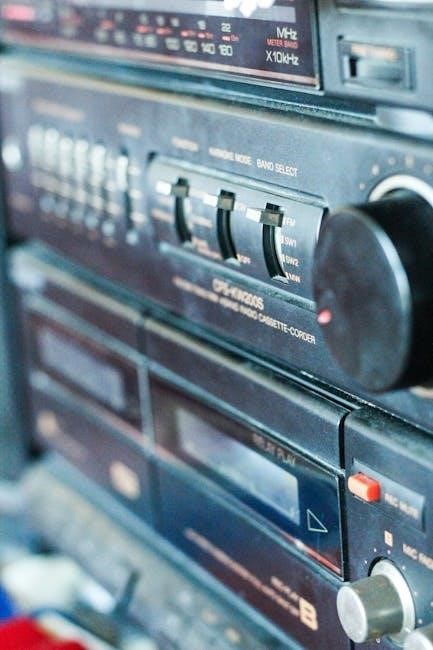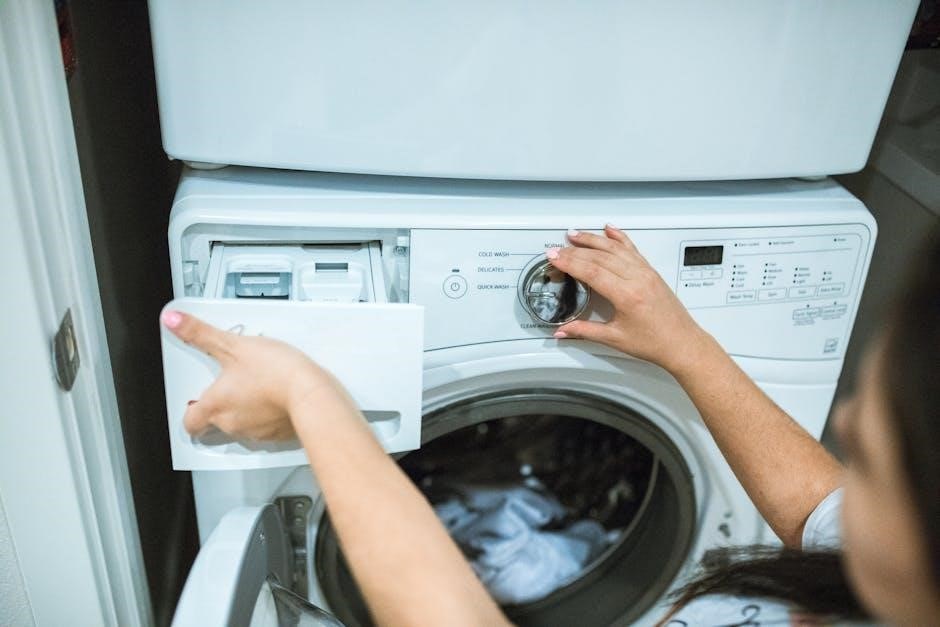The Reliance Transfer Switch Manual provides a comprehensive guide for installing and operating transfer switches, ensuring safe and reliable power management. Designed for residential and commercial use, these switches meet UL 1008 standards and NEC requirements, offering a durable solution for backup power systems. The manual covers key components, installation steps, and safety practices, making it an essential resource for both professionals and homeowners. Pro/Tran 2 Series models are highlighted for their efficiency and ease of use, ensuring seamless integration with generators and load centers. Follow the instructions carefully to ensure optimal performance and compliance with electrical codes.
What is a Transfer Switch?
A transfer switch is an electrical device designed to safely switch power sources between a primary utility supply and a backup generator. It ensures a seamless transition during power outages, preventing disruptions and potential damage to electrical systems. Available in both automatic and manual configurations, transfer switches are essential for residential and commercial backup power systems. They are typically installed between the main electrical panel and the generator, providing a reliable means to manage power distribution. The Reliance Transfer Switch is a loadside transfer switch, meeting UL 1008 standards and NEC requirements, ensuring compliance and safety for users. By isolating the generator from the utility grid, it prevents dangerous backfeeding and ensures efficient energy management during emergencies.
History of Reliance Transfer Switch
Reliance Controls Corporation, founded in 1969, has established itself as a leader in power management solutions. The company specializes in manual transfer switches, load centers, and generator accessories. Over the years, Reliance has built a reputation for producing high-quality, reliable products that meet stringent safety standards. The Reliance Transfer Switch has become a cornerstone of their product line, trusted by professionals and homeowners alike for backup power systems. With a focus on innovation, Reliance introduced the Pro/Tran 2 Series, a next-generation loadside transfer switch designed for ease of installation and seamless integration with generators. Today, Reliance transfer switches are widely recognized for their durability and compliance with UL 1008 and NEC requirements, making them a preferred choice in the market.
Key Components of the Reliance Transfer Switch
The Reliance Transfer Switch is built with high-quality components designed for durability and reliability. It features circuit breakers that protect against overloads and short circuits, ensuring safe power management. The switch includes a non-defeatable double-throw mechanism, preventing simultaneous connection to two power sources. A 16-inch flexible conduit whip simplifies installation by easily attaching to the load center. The switch also includes combination knockouts for flexible wiring options. These components are engineered to meet UL 1008 standards and National Electrical Code (NEC) requirements, ensuring compliance and safety. The design focuses on ease of use and longevity, making it a trusted solution for backup power systems in residential and commercial settings.

Key Features and Specifications
The Reliance Transfer Switch is UL 1008 listed, meeting NEC requirements for safety and reliability. It features a loadside design, 16-inch flexible conduit whip, and supports up to 10 circuits. The Pro/Tran 2 Series ensures efficient power management and seamless integration with generators and load centers, making it ideal for residential and commercial applications.
UL 1008 Listing and Compliance
The Reliance Transfer Switch is UL 1008 listed, ensuring compliance with rigorous safety and performance standards for transfer switches. This certification guarantees that the device can safely manage power transitions between primary and backup sources, meeting both U.S. and Canadian electrical codes. Compliance with UL 1008 involves extensive testing for durability, reliability, and adherence to strict safety protocols. The Pro/Tran 2 Series transfer switches are designed to handle emergency power needs efficiently, providing a secure connection for standby generators. By meeting UL 1008 standards, Reliance Transfer Switches offer users peace of mind, knowing their systems are protected against electrical hazards during power outages.
Loadside vs. Line-Side Transfer Switches
Reliance Transfer Switches are designed as Loadside devices, connecting between the generator and the load center. This configuration allows safe, manual switching between utility and generator power for specific circuits. In contrast, Line-Side switches are installed directly on the utility lines and generator, managing power before it reaches the load center. Loadside switches, like the Pro/Tran 2 Series, are preferred for residential use due to their simplicity, safety, and ease of installation. They ensure that only essential circuits are powered during outages, preventing overload and maintaining reliable operation. This design meets NEC requirements and provides homeowners with a user-friendly solution for backup power management.
National Electrical Code (NEC) Requirements
Reliance Transfer Switches are designed to meet or exceed National Electrical Code (NEC) requirements, ensuring safe and reliable power management. The switches are UL 1008 listed for standby power systems in both the U.S. and Canada. NEC guidelines dictate proper installation, wiring, and operation to prevent hazards and ensure compliance. Key requirements include proper sizing of conductors, grounding, and overcurrent protection. Loadside transfer switches, like the Pro/Tran 2 Series, must be installed on the load side of the service disconnect, maintaining separation from utility and generator power. Adhering to NEC standards ensures safe power distribution and avoids potential electrical hazards. Always consult local electrical codes and hire a licensed electrician for compliance.
Indoor Surface Mount Design
The Reliance Transfer Switch features an indoor surface mount design, ideal for residential and light commercial applications. Its compact and durable construction allows for easy installation on any interior wall, saving space while ensuring accessibility. The switch is designed with a 16-inch flexible conduit whip, simplifying connection to the load center. This indoor design ensures protection from outdoor elements, maintaining reliability and longevity. The surface mount configuration also enables quick access for maintenance and operation. With UL 1008 listing and NEC compliance, this design meets rigorous safety standards. The Pro/Tran 2 Series models are particularly noted for their streamlined installation process, making them a preferred choice for professionals and homeowners alike. This design ensures a secure and efficient backup power solution.

Installation and Setup
The Installation and Setup section guides users through preparing tools, wiring the switch, connecting to the load center, testing the system, and performing final safety checks. Essential steps ensure proper backup power functionality.
Tools Needed for Installation
Installing a Reliance Transfer Switch requires specific tools to ensure safety and efficiency. Essential tools include a screwdriver, wire connectors, voltage tester, drill, and bits. Additional items like conduit and cable ties may be needed. Proper tools ensure secure connections and compliance with electrical standards. Always refer to the manual for a detailed list tailored to your model. Using the right tools prevents errors and ensures reliable backup power functionality.
Pre-Installation Checklist
Before installing the Reliance Transfer Switch, ensure all preparations are complete. Review the manual thoroughly to understand requirements and safety guidelines. Verify the transfer switch is UL 1008 listed and meets NEC standards. Turn off the main power supply and confirm the circuit breaker size matches the switch’s capacity. Identify and label the circuits to be connected for backup power. Ensure the load center is compatible and has sufficient space for wiring. Double-check the generator’s power rating and compatibility with the switch. Gather all necessary tools and materials, such as wire connectors and conduit. Finally, ensure the installation area is clear and safe to work in. Proper preparation ensures a smooth and safe installation process.

Wiring the Reliance Transfer Switch
Wiring the Reliance Transfer Switch requires careful planning and adherence to electrical codes. Begin by identifying the circuits to be powered during an outage and ensure they are balanced between the generator’s legs for optimal performance. Connect the transfer switch to the load center using the 16-inch flexible conduit whip, securing it to a knockout. Follow the manual’s guidelines to wire each circuit selector switch, ensuring proper connections to avoid overloading the generator. Double-check all wire sizes and ratings to comply with UL 1008 and NEC standards. Use approved wire connectors and ensure all terminals are securely tightened. Finally, verify the wiring configuration matches the load center’s layout to ensure safe and reliable operation during power transfers.
Connecting to the Load Center
Connecting the Reliance Transfer Switch to the load center is a critical step in ensuring safe and reliable backup power. Begin by identifying the circuits you want to power during an outage and ensure they are selected in the transfer switch. Use the 16-inch flexible conduit whip to connect the switch to a knockout on the load center, securing it firmly. Match the wire connections from the transfer switch to the corresponding circuits in the load center, following the wiring diagram in the manual. Ensure all connections are tight and meet UL 1008 and NEC standards. For generators, verify the load center is compatible with the transfer switch and can handle the generator’s power output. Always consult a licensed electrician if unsure, especially for complex installations.
Testing the Transfer Switch
Testing the Reliance Transfer Switch ensures it operates correctly during power outages. Start by simulating a power outage and switching to generator power. Verify that the transfer switch activates seamlessly, supplying power to critical circuits. Check all connected loads to confirm proper functionality. Use a multimeter to measure voltage and ensure it matches the generator’s output. Inspect the switch for any signs of wear or damage. Perform this test with the main power disconnected to avoid electrical hazards. Follow the manual’s testing procedure for detailed steps. Regular testing ensures reliability and safety, guaranteeing your backup system is ready for emergencies. Always refer to the manual for specific testing guidelines and safety precautions.
Final Installation Checks
After completing the installation, perform a series of final checks to ensure the Reliance Transfer Switch operates safely and efficiently. Verify all connections are secure and properly tightened. Check that the load center links are correctly positioned and aligned with the transfer switch. Ensure the main breaker is in the “LINE” position and the transfer switch is set to “AUTO” or “MANUAL,” depending on your setup. Test the system under load to confirm it handles power distribution evenly. Inspect for any signs of damage or loose wiring. Finally, review the entire installation to ensure compliance with NEC standards and the manual’s guidelines. Have a licensed electrician verify the setup if unsure. This ensures your system is ready for safe and reliable operation during power outages.

Safety and Best Practices
Always turn off power before servicing the transfer switch. Follow NEC guidelines and manufacturer instructions to prevent electrical hazards. Ensure proper load management to avoid overloading circuits. Regular inspections and maintenance are crucial for safe operation. Use only UL-listed components and comply with local electrical codes. Never bypass safety features or exceed rated capacities. Keep the area around the switch clear of flammable materials. Proper grounding is essential for safety. Train users on manual transfer procedures to avoid accidents during power outages. Adhere to these best practices to ensure reliable and safe performance of your Reliance Transfer Switch.
Safety Precautions During Installation
Before starting installation, ensure the main power supply is turned off and verify with a voltage tester. Hire a licensed electrician if you lack experience. Always follow the manufacturer’s instructions and NEC guidelines. Wear protective gear, including insulated gloves and safety glasses. Properly ground the transfer switch to prevent electrical shock. Avoid overloading circuits, as this can cause fire hazards. Keep flammable materials away from the installation area. Double-check all connections for tightness and correctness. Never bypass safety features or skip steps to rush the process. Ensure the transfer switch is installed in a well-ventilated, dry location. Regularly inspect the system post-installation for any signs of wear or damage. Adhere to these precautions to ensure a safe and reliable setup.
Best Practices for Manual Transfer Switches

Always plan the installation carefully, ensuring the transfer switch is correctly sized for your generator and load requirements. Hire a licensed electrician for complex setups to guarantee compliance with local codes. Regularly test the switch to ensure smooth operation during power outages. Strategically select circuits to prioritize essential appliances like lighting, refrigeration, and medical equipment. Avoid overloading the generator by balancing high-wattage appliances across circuits. Keep the transfer switch accessible and labeled clearly for easy operation. Schedule annual inspections to check for wear, loose connections, or damage. Maintain a backup power plan to avoid overreliance on the generator. Follow the manufacturer’s maintenance recommendations to extend the lifespan of the switch. Proper documentation and user training are crucial for safe and efficient use.
Common Mistakes to Avoid
One of the most common mistakes is incorrect sizing of the transfer switch for the generator and load, leading to poor performance or safety hazards. Improper installation, such as ignoring local electrical codes or failing to ground the system, can result in dangerous conditions. Overloading the generator by connecting too many high-wattage appliances is another frequent error. Neglecting regular maintenance, like inspecting contacts or tightening connections, can cause malfunctions. Misconfiguring circuits or failing to balance the load between generator legs may overload one side, reducing efficiency. Using incompatible or damaged cables can compromise safety and functionality. Always follow the manufacturer’s instructions and consult a professional if unsure to avoid these costly and potentially dangerous mistakes.
Compliance with Electrical Standards
The Reliance Transfer Switch is designed to meet stringent electrical standards, including UL 1008 listing and compliance with the National Electrical Code (NEC). These certifications ensure the switch operates safely and efficiently under various conditions. Proper installation, as outlined in the manual, is crucial to maintaining compliance and avoiding potential hazards. The transfer switch must be sized correctly for the generator and load to prevent overloading or insufficient power delivery. Failure to comply with these standards can result in unsafe operating conditions, legal issues, or equipment damage. Always follow local electrical codes and consult a licensed professional if unsure to ensure full compliance and reliability of the system.

Troubleshooting and Maintenance
Regular inspections and maintenance ensure optimal performance of the Reliance Transfer Switch. Check for worn parts, secure connections, and follow the manual’s guidance to resolve common issues promptly.
Common Issues and Solutions
Users may encounter issues such as circuit overload, switch wear, or incorrect wiring. To address these, ensure loads are balanced across circuits and avoid exceeding generator capacity. Inspect switches for wear and replace them if necessary. Verify wiring connections match the manual’s guidelines. Another common issue is generator sizing; ensure the generator’s capacity aligns with the load requirements. If the switch fails to transfer power, check for loose connections or tripped breakers. Regular maintenance, such as cleaning contacts and tightening connections, can prevent many issues. Always refer to the Reliance Transfer Switch Manual for specific troubleshooting steps and solutions to ensure safe and reliable operation.
Maintenance Schedule
Regular maintenance is essential to ensure the Reliance Transfer Switch operates efficiently and safely. Inspect the switch and connections every 6 months for signs of wear or corrosion. Clean dust and dirt from the switch and connections to prevent electrical issues. Lubricate moving parts annually to maintain smooth operation. Test the transfer switch monthly by simulating a power outage to ensure proper function. Check circuit breakers for proper alignment and reset them if necessary. Replace any worn or damaged components immediately. Keep a maintenance log to track inspections and repairs. Always follow the manufacturer’s guidelines for maintenance procedures to ensure compliance with safety standards and optimal performance. Regular upkeep helps extend the lifespan of the transfer switch and ensures reliable power during emergencies.
Upgrading or Replacing the Transfer Switch
Upgrading or replacing the Reliance Transfer Switch may be necessary due to outdated models, increased power requirements, or wear and tear. Before upgrading, consult the manual to ensure the new switch is compatible with your electrical system; Verify the switch meets UL 1008 standards and NEC requirements for safety and compliance. When replacing, disconnect power and follow the installation instructions carefully to avoid damage or electrical hazards. Consider professional assistance for complex upgrades. Always purchase genuine Reliance components to maintain reliability and performance. Regularly check for firmware updates or new models to enhance functionality. Proper installation ensures seamless integration with your generator and load center, guaranteeing reliable backup power during outages.

Additional Resources
For further assistance, explore the Reliance Pro/Tran 2 Series Manual, Home Integration Kit (HIK) details, and customer support resources for comprehensive guidance and troubleshooting.
- Reliance Pro/Tran 2 Series Manual
- Home Integration Kit (HIK) Details
- Customer Support and Warranty Information
Reliance Pro/Tran 2 Series Manual
The Reliance Pro/Tran 2 Series Manual offers detailed instructions for installing, configuring, and maintaining the Pro/Tran 2 transfer switches. This manual is designed to ensure compliance with safety standards and optimal performance. It covers compatibility with generators, load centers, and portable power stations, emphasizing proper wiring and setup. Key features include step-by-step installation guides, troubleshooting tips, and compliance information for UL 1008 and NEC requirements. The manual also highlights the indoor surface-mount design, making installation faster and more efficient. By following the guidelines, users can ensure a seamless integration of their backup power system, guaranteeing reliability during outages.
- Detailed installation and configuration steps
- Compatibility with generators and load centers
- Compliance with UL 1008 and NEC standards
- Troubleshooting and maintenance tips
Home Integration Kit (HIK) Details
The Home Integration Kit (HIK) is designed to seamlessly connect your backup power system to your home’s electrical panel. This kit includes a Reliance Pro/Tran 2 Series 15-Amp, 4-Circuit, 120V manual transfer switch, allowing you to customize your backup power by selecting up to 4 essential circuits from your breaker panel. It also includes a 10-foot extension cable for connecting to a Yeti Portable Power Station. The HIK ensures safe and efficient power transfer during outages, with a focus on easy installation when working with a licensed electrician. For optimal performance, pair it with a compatible Yeti power station (sold separately). This system is ideal for homeowners seeking a reliable and scalable backup solution.
- Includes a 15-Amp, 4-Circuit, 120V transfer switch
- Customizable backup power for up to 4 circuits
- Compatible with Yeti Portable Power Stations
- 10-foot extension cable for easy connection
- Requires installation by a licensed electrician
Customer Support and Warranty Information
Reliance Controls Corporation offers dedicated customer support to assist with inquiries, troubleshooting, and warranty claims. Products like the Pro/Tran 2 Series come with a comprehensive warranty, ensuring coverage for defects in materials and workmanship. For detailed warranty terms, visit their official website or contact their support team directly. Additionally, Reliance provides extensive online resources, including manuals, FAQs, and installation guides, to help users maintain and repair their transfer switches. Their commitment to quality and customer satisfaction has established them as a trusted brand in the industry. Always verify warranty conditions and register your product to ensure full coverage and support benefits.

Accessories and Compatibility
The Reliance Transfer Switch is compatible with various accessories, including Yeti Portable Power Stations and Goal Zero products. The Home Integration Kit (HIK) enhances backup power solutions, while transfer switch kits and extension cables ensure seamless connectivity to generators and load centers. These accessories are designed to optimize performance and simplify installation processes for reliable power management.
Compatible Portable Generators

The Reliance Transfer Switch is designed to work seamlessly with a variety of portable generators, ensuring reliable backup power during outages. Popular options include the Goal Zero Yeti Portable Power Stations, which integrate effortlessly with the Home Integration Kit (HIK) for a customized backup solution. Additionally, generators like the Jackery Explorer 3000 Pro are highly recommended for their compatibility and high-performance capabilities. These portable generators are UL 1008 listed and meet NEC requirements, ensuring safety and compliance. The transfer switch supports up to 4 circuits, allowing homeowners to prioritize essential appliances. For optimal performance, it’s crucial to select a generator that matches the power requirements of your home. Always consult the manufacturer’s specifications and compatibility charts to ensure a safe and efficient setup.
Recommended Yeti Portable Power Stations
For optimal performance with the Reliance Transfer Switch, the Goal Zero Yeti Portable Power Stations are highly recommended. Models like the Yeti 1000, 1500, and 3000 offer reliable backup power solutions. These stations feature advanced lithium-ion batteries, solar charging capabilities, and high power output to support essential appliances during outages. The Yeti 3000, in particular, is praised for its high capacity and seamless integration with the Home Integration Kit (HIK). Designed to meet UL and NEC standards, these power stations ensure safety and compliance. They allow for customizable backup solutions by selecting specific circuits from your breaker panel, making them ideal for homeowners seeking efficient and scalable backup power systems.
Transfer Switch Kits and Extensions
Reliance offers comprehensive transfer switch kits and extensions to enhance your backup power system. The Pro/Tran 2 Series transfer switch kits, such as the 310CRK, include everything needed for a seamless installation, including the switch, wiring, and connectors. These kits are designed for residential use, supporting up to 10 circuits and ensuring safe, reliable power distribution. Extensions like the Yeti 10-foot extension cable provide flexibility for connecting portable power stations to the transfer switch. These kits and extensions are compatible with Goal Zero Yeti portable power stations, allowing for easy integration into your home backup system. They meet NEC requirements and are designed for durability, ensuring a safe and efficient power management solution during outages.
